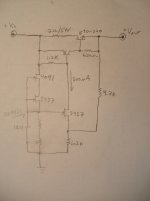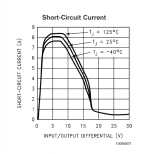Is the output bypass cap a really low ESR type? If so, it could be causing instability in the regulator. This is one of those applications where "good" parts are a detriment.
You shouldn't see more than 2A at turn on with a 10R in series, so it's doubtful that a turn on surge is the issue.
What is the input voltage to the regulator? You might be exceeding the thermal limits - the chip could get hot and shut down before the heat sink has a chance to get warm, especially if the mounting doesn't provide for good transfer. Unfortunately, the data sheet doesn't specify the maximum dissipation. See the section of overload protection.
For a voltage regulated solution, you can spread the heat load around using an MJE15030 or two to carry the current, using the LM1048 to drive their bases, as suggested by kavermei.
You shouldn't see more than 2A at turn on with a 10R in series, so it's doubtful that a turn on surge is the issue.
What is the input voltage to the regulator? You might be exceeding the thermal limits - the chip could get hot and shut down before the heat sink has a chance to get warm, especially if the mounting doesn't provide for good transfer. Unfortunately, the data sheet doesn't specify the maximum dissipation. See the section of overload protection.
For a voltage regulated solution, you can spread the heat load around using an MJE15030 or two to carry the current, using the LM1048 to drive their bases, as suggested by kavermei.
The LM338 is rated at 5 AMP, dissipating around 60 watts with a good heatsink, and it's self protected
Here is a simple little circuit I like to use. It is a series regulator without any noisy Zeners . The 5457 J-fet Idss is about 1-3mA and would have to be measured in order to choose the correct value resistor and pot for the correct voltage. A trivial task.🙄 The PNP transistor can be any old small signal device, there are plenty to choose from for that voltage range....2N3906 would be fine. The TO-220 can be any general device as well, 2N3055 or something. Might need its heat sinked of course. Values are arbitrary to realitive currents so they aren't set in stone.😉
. The 5457 J-fet Idss is about 1-3mA and would have to be measured in order to choose the correct value resistor and pot for the correct voltage. A trivial task.🙄 The PNP transistor can be any old small signal device, there are plenty to choose from for that voltage range....2N3906 would be fine. The TO-220 can be any general device as well, 2N3055 or something. Might need its heat sinked of course. Values are arbitrary to realitive currents so they aren't set in stone.😉
 . The 5457 J-fet Idss is about 1-3mA and would have to be measured in order to choose the correct value resistor and pot for the correct voltage. A trivial task.🙄 The PNP transistor can be any old small signal device, there are plenty to choose from for that voltage range....2N3906 would be fine. The TO-220 can be any general device as well, 2N3055 or something. Might need its heat sinked of course. Values are arbitrary to realitive currents so they aren't set in stone.😉
. The 5457 J-fet Idss is about 1-3mA and would have to be measured in order to choose the correct value resistor and pot for the correct voltage. A trivial task.🙄 The PNP transistor can be any old small signal device, there are plenty to choose from for that voltage range....2N3906 would be fine. The TO-220 can be any general device as well, 2N3055 or something. Might need its heat sinked of course. Values are arbitrary to realitive currents so they aren't set in stone.😉Attachments
Why I don't know, but the damn LM1084 just shuts down. The steady current is only 1.25A but maybe it's the initial voltage that triggers the shut down - the supply is 33v off load - or the current surge on switch on or something. It's frustrating.
At 33V in, you could be exceeding the absolute maximum input-output voltage rating for the part (29V) if you're charging an output capacitance on switch on.
Maybe the regulator has a foldback type current limiter. I've run into similar problems with large diesel glow plugs (although not with this regulator type).
Why I don't know, but the damn LM1084 just shuts down.
andy
The 5A limit is only true under certain conditions.
The maximum Power dissipation for the LM1084 is 30W which means at 33V in and 5V out, your maximum current is = 30/(33-5) = 1 Amp.
also see this graph (image attached):
Attachments
hello.
have you tried out to disconnect the regulator from the tube filament.......and load it with a res (a few 100 ohm) or something else...........
greets
have you tried out to disconnect the regulator from the tube filament.......and load it with a res (a few 100 ohm) or something else...........
greets
Ah - so the output capacitor may be the problem. It's 220uF. Another post has suggested low ESR may not be good either. Do I need an output cap here? The data also specifies a tantalum at 10uF, if that would be better. Ideas?
andy
andy
Well, I tried out the LM1084 in CCS mode, and it works fine, so that's one result.
As for sound quality, I'm not sure it's the best option. Thomas Mayer, who started all this filament bias stuff with the 10Y DHT, stated he didn't like a CCS in this position. He used a second choke connected directly to the opposite side of the filament from the cathode resistor. The CCS seems to sound smooth but a bit lifeless. The choke is very detailed with much better bass and dynamics, but is hard through the midrange. I wonder if there's a resonance somewhere. So complicated, filament bias.
So I think the hunt is still on for the best sound.
andy
As for sound quality, I'm not sure it's the best option. Thomas Mayer, who started all this filament bias stuff with the 10Y DHT, stated he didn't like a CCS in this position. He used a second choke connected directly to the opposite side of the filament from the cathode resistor. The CCS seems to sound smooth but a bit lifeless. The choke is very detailed with much better bass and dynamics, but is hard through the midrange. I wonder if there's a resonance somewhere. So complicated, filament bias.
So I think the hunt is still on for the best sound.
andy
- Status
- Not open for further replies.
- Home
- Amplifiers
- Solid State
- Need voltage regulator 20v at 3A - ideas?

